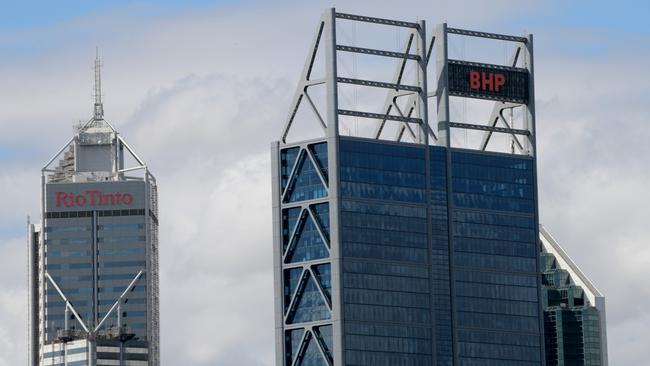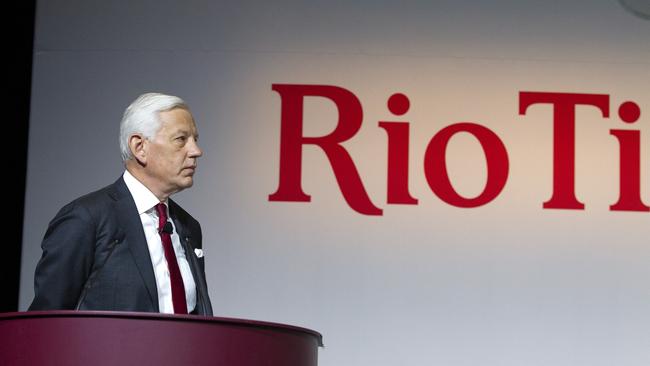Goldman Sachs predicts high costs and dividend danger in a Rio Tinto single listing
Abandoning a dual-listed structure could cost Rio Tinto billions of dollars more and make it harder to pay fully franked dividends to Australian shareholders, says Goldman Sachs.

Business
Don't miss out on the headlines from Business. Followed categories will be added to My News.
Goldman Sachs believes Rio Tinto ditching its dual-listed structure may cost the miner billions of dollars more than previously estimated and reduce its ability to pay fully franked dividends to Australian shareholders.
The investment bank said the total cost of collapsing the dual-listed structure could be in a range of $US7bn-$US15bn ($11bn-$24bn) with likely negative effects on the balance sheet, dividends and growth.
The warning came in the countdown to a vote on the issue by London shareholders.
Rio has estimated the tax cost alone would be “mid-single digit” billions of dollars and its Dominic Barton-led board has been unanimous in recommending shareholders vote against the proposal.
Activist hedge fund Palliser Capital wants Rio to ditch its main London listing because its shares trade at a higher premium on the ASX.
London shareholders will on Thursday vote on a motion to force Rio to conduct a strategic review of its structure, with big investors and shareholder advisory firms split on the issue. Australian shareholders will have their say on May 1.
The proposal requires a 75 per cent majority of PLC (London) and Ltd (Australian) shareholders to pass, with the result to hinge on the London vote given 77 per cent of shareholders own the PLC stock.

Barclays analysts said Rio may need to carry out the independent review even if the Palliser motion fails to gain anything like a 75 per cent majority.
“Our discussions with and recent statements from active managers on both sides of the DLC suggest limited appetite to vote in favour,” Barclays analysts said.
“If more than 20 per cent of shareholders vote in favour of the resolution, UK corporate governance standards require the board to consult shareholders to understand the reasons behind the result and update on views received and actions taken within six months.”
The Goldman Sachs team said assuming no rollover relief or special concessions, collapsing the dual listing could cost shareholders $US5bn-$US7bn in capital gains tax.
Other negatives included a stamp duty bill of $US400m associated with issuing Australian shares and the cancellation of British shares, and a loss of tax benefits associated with marketing products through Singapore.
Goldman Sachs estimated the cost of foregoing the ability to continue to pay fully franked dividends to Australian shareholders at $US3.4bn. This was based on the geographic split of Rio’s future earnings not generating sufficient franking credits to underpin fully franked dividends.
The analysis concluded the various costs could push net debt beyond $US20bn and may lead to “delay in key growth projects, impacting the ability for Rio to maintain its 60 per cent dividend payout ratio, and limit its ability to pursue inorganic growth”.
In contrast, Barclays said there would be some benefits to unifying the dual listing structure, including increased access to franking credits for Australian holders, eliminating Ltd cash transfers to PLC to fund dividend payments, simplification of group structure, and a more fit-for-purpose structure for scrip acquisitions. Under the Rio structure in place since 1995, all profits and assets are shared between the London and Australian listed companies and shareholders treated equally. However, the ASX-listed shares have traded at a premium, attributed to tax breaks on dividends.
Palliser, which says it controls more than $US300m in Ltd and PLC shares, was formed by James Smith and others who worked at Elliott Management when it was instrumental in the unification of BHP’s listings in Britain and Australia.
“All we are asking is for the (Rio) board to simply conduct a full, fair, and transparent review on the merits of DLC unification, which we believe to be the lowest risk, highest return form of capital allocation that the company has available today,” Palliser has said of its motion.
Shareholder advisory firms Institutional Shareholder Services and Glass Lewis are supporting the motion.
More Coverage
Originally published as Goldman Sachs predicts high costs and dividend danger in a Rio Tinto single listing





